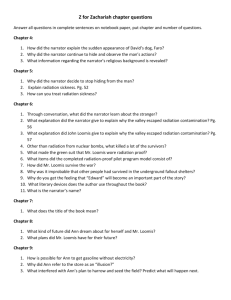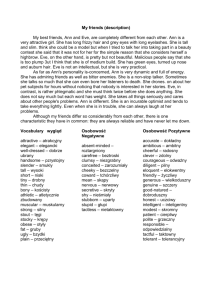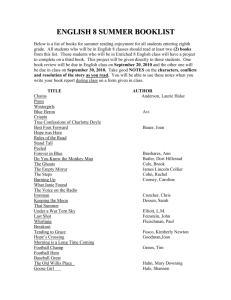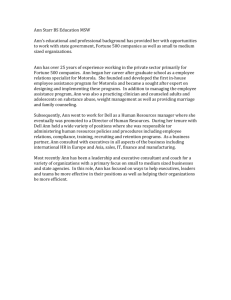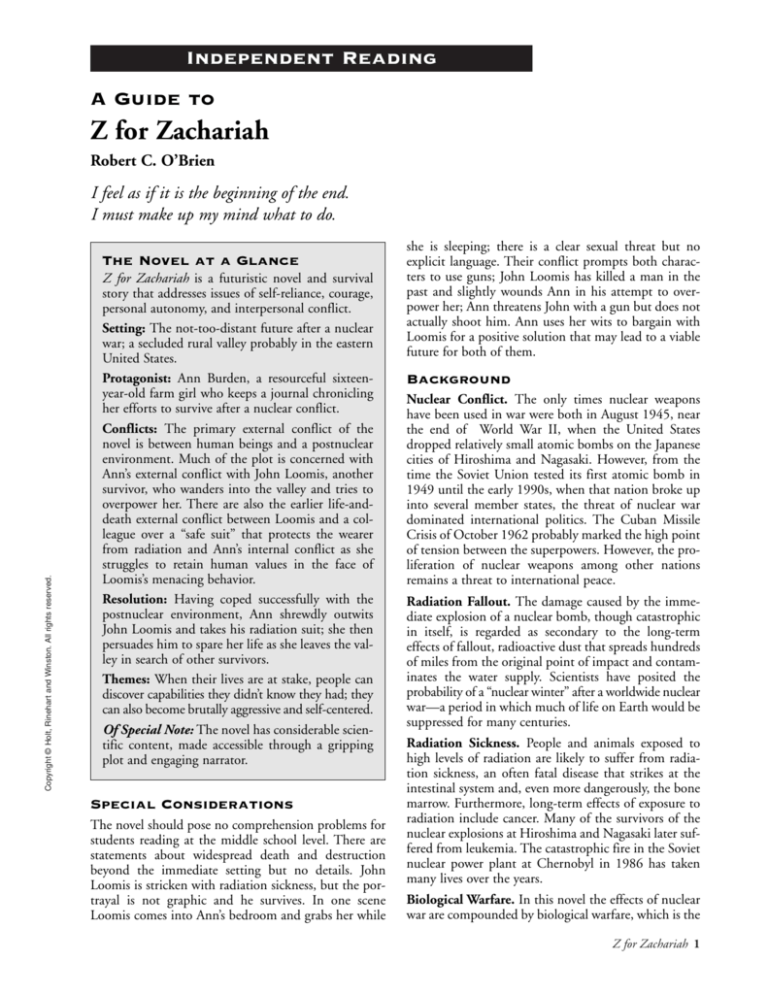
Independent Reading
A Guide to
Z for Zachariah
Robert C. O’Brien
I feel as if it is the beginning of the end.
I must make up my mind what to do.
Copyright © Holt, Rinehart and Winston. All rights reserved.
The Novel at a Glance
Z for Zachariah is a futuristic novel and survival
story that addresses issues of self-reliance, courage,
personal autonomy, and interpersonal conflict.
Setting: The not-too-distant future after a nuclear
war; a secluded rural valley probably in the eastern
United States.
Protagonist: Ann Burden, a resourceful sixteenyear-old farm girl who keeps a journal chronicling
her efforts to survive after a nuclear conflict.
Conflicts: The primary external conflict of the
novel is between human beings and a postnuclear
environment. Much of the plot is concerned with
Ann’s external conflict with John Loomis, another
survivor, who wanders into the valley and tries to
overpower her. There are also the earlier life-anddeath external conflict between Loomis and a colleague over a “safe suit” that protects the wearer
from radiation and Ann’s internal conflict as she
struggles to retain human values in the face of
Loomis’s menacing behavior.
Resolution: Having coped successfully with the
postnuclear environment, Ann shrewdly outwits
John Loomis and takes his radiation suit; she then
persuades him to spare her life as she leaves the valley in search of other survivors.
Themes: When their lives are at stake, people can
discover capabilities they didn’t know they had; they
can also become brutally aggressive and self-centered.
Of Special Note: The novel has considerable scientific content, made accessible through a gripping
plot and engaging narrator.
Special Considerations
The novel should pose no comprehension problems for
students reading at the middle school level. There are
statements about widespread death and destruction
beyond the immediate setting but no details. John
Loomis is stricken with radiation sickness, but the portrayal is not graphic and he survives. In one scene
Loomis comes into Ann’s bedroom and grabs her while
she is sleeping; there is a clear sexual threat but no
explicit language. Their conflict prompts both characters to use guns; John Loomis has killed a man in the
past and slightly wounds Ann in his attempt to overpower her; Ann threatens John with a gun but does not
actually shoot him. Ann uses her wits to bargain with
Loomis for a positive solution that may lead to a viable
future for both of them.
Background
Nuclear Conflict. The only times nuclear weapons
have been used in war were both in August 1945, near
the end of World War II, when the United States
dropped relatively small atomic bombs on the Japanese
cities of Hiroshima and Nagasaki. However, from the
time the Soviet Union tested its first atomic bomb in
1949 until the early 1990s, when that nation broke up
into several member states, the threat of nuclear war
dominated international politics. The Cuban Missile
Crisis of October 1962 probably marked the high point
of tension between the superpowers. However, the proliferation of nuclear weapons among other nations
remains a threat to international peace.
Radiation Fallout. The damage caused by the immediate explosion of a nuclear bomb, though catastrophic
in itself, is regarded as secondary to the long-term
effects of fallout, radioactive dust that spreads hundreds
of miles from the original point of impact and contaminates the water supply. Scientists have posited the
probability of a “nuclear winter” after a worldwide nuclear
war—a period in which much of life on Earth would be
suppressed for many centuries.
Radiation Sickness. People and animals exposed to
high levels of radiation are likely to suffer from radiation sickness, an often fatal disease that strikes at the
intestinal system and, even more dangerously, the bone
marrow. Furthermore, long-term effects of exposure to
radiation include cancer. Many of the survivors of the
nuclear explosions at Hiroshima and Nagasaki later suffered from leukemia. The catastrophic fire in the Soviet
nuclear power plant at Chernobyl in 1986 has taken
many lives over the years.
Biological Warfare. In this novel the effects of nuclear
war are compounded by biological warfare, which is the
Z for Zachariah 1
Main Characters
(in order of appearance)
Ann Burden, an intelligent, resourceful girl of nearly
sixteen; survives on her own for nearly a year after
nuclear and biological warfare seems to have destroyed
all traces of life in the world outside her valley.
John Loomis, a chemist in his thirties; has developed a
radiation-proof suit and walks from Cornell University
to Ann’s valley in search of other living beings.
Plot
Chapter One. We meet the novel’s main character and
her setting. The narrator, who we later learn is named
Ann Burden, writes in her journal on May 20 that she
has seen distant smoke and fears that someone is coming to her valley. She has been living alone for about a
year. She introduces one of the novel’s central conflicts
by explaining in her journal that the year before there
had been a nuclear war whose side effects have penetrated to her isolated rural home. At the time her parents, a cousin, and some neighbors drove to a nearby
community to look for survivors. When no one
returned from this expedition, Ann concluded that her
family and everyone else she knew had died. Her own
valley is still green, but she sees only wasteland beyond it.
Chapter Two. Ann sees the smoke coming closer each
day. To ensure her safety, she turns loose her livestock,
tears up her garden, and moves to a cave near her house.
She describes some of the survival strategies she practiced over the past year. Fortunately, a nearby church
and store remain radiation-free like her farm. One
brook near her home also remains pure; another is
contaminated, a significant detail of the setting.
Introducing her internal conflict, she wonders
whether she should ever show herself to the wanderer,
who, as she now sees from her lookout, is a man
entirely covered by a helmeted suit and hauling a
wagon. This man is the novel’s only other character.
Chapter Three. The stranger, surprised by the valley’s
green life, checks for radiation with a Geiger counter.
He pulls off his helmet, and Ann sees his face for the
first time. The stranger investigates Ann’s house but
sleeps outside in his tent. The next day he goes exploring; he checks the pure brook but later bathes in the
contaminated one, mistakenly assuming they come
from the same source, introducing an important complication into the plot.
Chapter Four. Faro, Ann’s cousin’s dog, returns after
being gone for many months. The stranger befriends
the dog, and Ann worries that Faro will lead the man to
her cave hideout. The stranger discovers his mistake
2 Z for Zachariah
about the contaminated stream; soon after he grows ill
and crawls into his tent.
Chapter Five. The man remains in his tent. Faro,
bewildered by his new friend’s behavior, visits Ann for
food. After a dream about her family, Ann momentarily resolves her internal conflict and cautiously visits
the sick man, who deliriously addresses her as
“Edward,” foreshadowing another conflict. When she
returns to feed the man, he is weak but coherent. She
explains about Burden Creek and checks its radiation
level for him. The man concludes grimly that he has a
bad case of radiation poisoning, explaining that he will
improve temporarily and then grow gravely, possibly
fatally, ill.
Chapter Six. Ann persuades the man to move into her
house. He provides background information, revealing that he is John Loomis, a chemist at Cornell
University who worked on a team that developed
radiation-protection gear, including a suit, and air and
water filters. However, only one set of equipment had
been completed before fighting erupted. During the
weeklong war, Loomis remained safe in an underground laboratory. After a few months he put on the
suit and walked to a subterranean military post near
Chicago, where he found evidence of a battle that had
left everyone dead. When Ann asks about Edward, the
name he called out in his delirium, Loomis looks
shocked; he says briefly that Edward was a colleague of
his at Cornell.
Chapter Seven. Loomis and Ann work on the garden
and discuss the possibility of using her father’s tractor.
Homesick for her old life, Ann considers returning to
the cave for privacy; then she finds Loomis thrashing
around, having a nightmare in which he is reliving an
argument with Edward, who apparently tried to leave
the lab to find his wife and child after the war. Ann
decides to stay in the house in case Loomis needs help.
Chapter Eight. The next morning Ann collects greens
for a salad and daydreams about marrying Loomis. She
finds him testing the contaminated stream, and he confirms the bad news she gave him about the radiation.
They discuss building an electrical generator. Then he
suddenly grows weak as his disease enters its serious phase.
Chapter Nine. With Loomis’s help Ann figures out
how to operate a gasoline pump without electricity and
so gets the tractor running. She is pleased that she does
not have to rely on the supplies at the store. She happily plows the field to prepare for planting corn. That
night Loomis’s fever shoots up.
Chapter Ten. Loomis sleeps most of the time as his
struggle with radiation sickness approaches a crisis. At
one point, however, Loomis gets up, hauls a rifle from
his wagon, and fires at the house, insisting that he heard
someone inside. Later he asks if Edward is gone but
then says Edward is dead. Ann wonders why Loomis
seems so afraid of Edward.
Copyright © Holt, Rinehart and Winston. All rights reserved.
military use of germs, viruses, and other agents that
cause disease. In 1972 (just before this novel was written), many nations signed a treaty outlawing the testing
and use of biological weapons.
Copyright © Holt, Rinehart and Winston. All rights reserved.
Chapter Eleven. Loomis’s condition grows worse. He is
often delirious, reliving the confrontation with Edward,
the apparent resolution of that earlier conflict. Ann
surmises that Loomis shot Edward when Edward tried
to steal the radiation suit. Loomis is so ill that Ann goes
to the little church to pray for him. Pulled in different
directions by her internal conflict, she decides that she
does not want him to die, even if he is a murderer.
Chapter Eighteen. On the evening after the reading,
Loomis asks Ann to play the piano but again acts oddly.
The next night, Ann wakes up to find Loomis in her
room. Loomis moves his hands over her “not roughly
but in a dreadful, possessive way.” Feigning sleep, Ann
knows “what he was planning to do,” and, jabbing him
in the throat, she runs from the house.
Chapter Twelve. Loomis survives a difficult night but
remains gravely ill. Ann goes to church again and rescues a fallen baby crow—a good omen, she thinks. She
mulls over what she has learned about Loomis and
Edward, trying to fathom Loomis’s reasons for shooting
Edward. She decides she cannot judge Loomis’s action
until she knows what he is really like. The next day,
Loomis’s breathing seems deeper.
Chapter Nineteen. The setting becomes an increasingly important factor in the conflict between Ann and
Loomis. Ann stocks her cave with supplies from the
store. She suspects that Loomis plans to use Faro to
track her. Cruelly, he tethers the dog to the porch.
Despite her fear of him, Ann decides that she can’t let
the man starve. She will gladly let him have the house
and work for their mutual survival, if only he will let
her live separately in peace.
Chapter Thirteen. Loomis improves but remains
unconscious. Ann thinks about her prewar plans to
teach English. She thinks about borrowing the safe suit
to go to the library in Ogdentown, the nearest town,
which is contaminated. On June 8 Loomis wakes up;
his fever is down but he is thin and very weak.
Chapter Twenty. Ann makes her bargain with Loomis.
That night, Loomis drives the tractor in an unsuccessful attempt to track Ann to her hideout. Watching
through binoculars, Ann wishes Loomis had never
come to her valley. She then wonders if other regions
remain uncontaminated and inhabited with survivors.
Chapter Fourteen. On June 15 Ann celebrates her sixteenth birthday. Loomis has continued to improve,
although he cannot walk steadily yet. As Ann turns to
her other, neglected chores, Loomis reveals a possessive
interest in the farm—a new complication in the plot.
Ann sees that he has begun to consider the farm and
valley as much his as hers.
Chapter Twenty-one. Several weeks pass; it is August
4, and Ann explains that she hasn’t written in her journal because Loomis has shot and wounded her. In a
flashback she explains that, for a short time, her system
of living outside the house in peaceful coexistence with
Loomis seemed to be working. After about two weeks
Loomis tells her that he is keeping the tractor key in the
house and that as long as she continues “this stupidity,
this staying away, there are things you are going to have
to do without.” Ann realizes that he is afraid she will
steal the tractor.
Chapter Fifteen. In the next week Loomis becomes
obsessed with walking on his own. He and Ann discuss
visiting the Ogdentown library; Loomis is interested
only in technical books and disparages Ann’s desire for
novels. However, when Ann offers to wear the radiation
suit and drive the tractor to Ogdentown, Loomis
angrily warns her never to touch the suit. His character is developing in new, disturbing directions. He tells
Ann that they have to plan “as if this valley is the whole
world and we are starting a colony.” His words make
her uneasy.
Chapter Sixteen. Ann decides she needs to know
Loomis better. After some innocuous questions, she asks
if he has ever been married. He reacts strangely, tells her
he has not been married, and grabs her hand; the
exchange leads Ann to strike his face by accident.
Loomis becomes angry, and Ann begins to be concerned
about his growing physical strength, foreshadowing a
physical and psychological conflict between them.
Chapter Seventeen. On June 30 Ann reveals that she
has moved back to the cave and explains why in a flashback. The morning after the confrontation over marriage, Ann tries to return to normal but grows nervous
again when Loomis watches her every move in the cornfield. After some stilted conversation, Loomis asks Ann
to read aloud to him, but she feels that he is trying to
trick her since he doesn’t seem to listen to what she reads.
Chapter Twenty-two. Soon after, Ann sees Loomis
drive the tractor fast toward the store, carrying his rifle.
After searching the living quarters above the store for
evidence of Ann, he padlocks the doors to the store,
adding a new complication to their conflict.
Chapter Twenty-three. Ann understands that Loomis
intends to starve her out. Struggling with her internal
conflict, she wonders whether the radiation sickness or
his long isolation has affected his mind. Pitying him, she
approaches the house to talk, but Loomis shoots her in
the ankle. She is able to escape and realizes that he tried
to injure her in order to capture her alive. Ann grasps
that her situation is desperate. She loads her father’s gun,
which she had been keeping in her cave, intending to
shoot Faro to prevent Loomis from tracking her. As Faro
leads Loomis toward the cave, Ann prepares to shoot,
but the dog’s sudden movement stops her. Loomis finds
the cave and burns everything there. Ann feels like a
murderer because she had intended to kill Faro.
Chapter Twenty-four. On August 6 Ann decides that
she will steal the safe suit and leave the valley to seek
another pocket of survivors; she dreams of finding a
group of schoolchildren to teach; her dream points
Z for Zachariah 3
Chapter Twenty-five. The next day Ann writes that she
now has the safe suit, having tricked Loomis by leaving
a note at the house asking him to meet her unarmed.
Loomis reads the note and heads out with his gun.
After he goes out Ann takes the suit, radiation filters,
and wagon from the farm. She knows that Loomis will
try to kill her; nevertheless, she cannot leave without
talking to him. She puts on the radiation suit and waits
for him on the road to Ogdentown, prepared to die.
Chapter Twenty-six. In the novel’s climax Loomis
finds Ann and begins to shoot, demanding that she
return the suit. When she brings up his murder of
Edward, Loomis falters. Ann explains that she wants to
live among other survivors, and Loomis begs her not to
leave him alone. Ann argues that if he kills her, he will
be alone, but if he lets her go, she could send other survivors to rescue him. Then she turns away, expecting
him to shoot. Instead, he calls to her and points west,
saying that he saw some birds there, signaling the resolution to their conflict. Ann walks off, searching the
western horizon for “a trace of green.”
Approaches for
Post-Reading Activities
The outstanding element of this novel is its treatment
of scientific information, which is made accessible
through the gripping conflict and engaging point of
view. Discussion groups or individual research projects
might focus on the following activities.
1. Investigating the Scientific Basis of the Novel
Many readers will want to know whether the novel’s
portrayal of a postnuclear world is realistic. Questions
such as “Would destruction be as widespread as it is
Copyright © by Holt, Rinehart and Winston, Inc.
All rights reserved. No part of this publication may be reproduced
or transmitted in any form or by any means, electronic
or mechanical, including photocopy, recording, or any information
storage and retrieval system.
Printed in the United States of America
4 Z for Zachariah
in the novel?” and “What happens to living things that
are exposed to radiation?” could lead to an investigation of the scientific basis of the novel.
• The causes and effects of radiation from a nuclear
explosion
• The course and treatement of radiation sickness
• Safe and unsafe levels of radiation exposure
2. Evaluating Credibility and Relevance
Discussion groups might focus on other specific elements of the novel:
• How engaging and realistic are the characters? How
believable are their actions?
• How gripping is the conflict between the characters? How credible is its resolution?
• What are the novel’s most important themes? Do
these themes seem important in the world today?
How have these themes been treated in movies and
on television?
Meet the Writer
Robert C. O’Brien (1918?–1973) was born Robert
Leslie Conly. Under the pseudonym Robert C.
O’Brien, he began his writing career in journalism,
working for such publications as National Geographic
and Newsweek. Z for Zachariah, the last of his five
works of fiction, was published posthumously in 1974.
It won the Jane Addams Children’s Books Award in
1976, and the Mystery Writers of America award in
1977 for the best juvenile novel.
Read On
Robert C. O’Brien, Mrs. Frisby and the Rats of NIMH.
A science fiction novel. A rat civilization struggles to
coexist with human society. The novel was made into a
popular film; it won the 1972 Newbery Medal and was
a runner-up for the 1972 National Book Award.
Ray Bradbury, “There Will Come Soft Rains.” A
famous short story, set in California in 2026, in which
there are no human beings at all.
A. B. Guthrie, “Bargain.” A classic Western short
story set in a town called Moon Dance. The “good
guys” and the “bad guys” can be recognized at once, but
will the good guys win out in the end?
Rudyard Kipling, “Rikki-tikki-tavi.” A famous short
story about an indomitable animal character who finds
the strength to overcome overwhelming forces.
Copyright © Holt, Rinehart and Winston. All rights reserved.
toward the novel’s resolution. Loomis has left her alone
for a month, during which she has foraged for food.
She knows that she will have to act soon, for fall is coming. One day, Loomis flushes her out by leaving the
door to the store open; after his shot misses her, he follows Ann with Faro. Ann gets her gun and deliberately
leads them toward the contaminated creek. Drawn by
her scent, Faro tries to jump into the water. Loomis
holds him back but, when Ann shoots over the man’s
head, he runs for cover and the dog plunges into the
creek, eventually swimming to Ann. She takes Faro to
her camp, knowing Loomis will not follow since she is
armed. Faro dies the next day. Ann decides that it is
time to put her plan into action.

